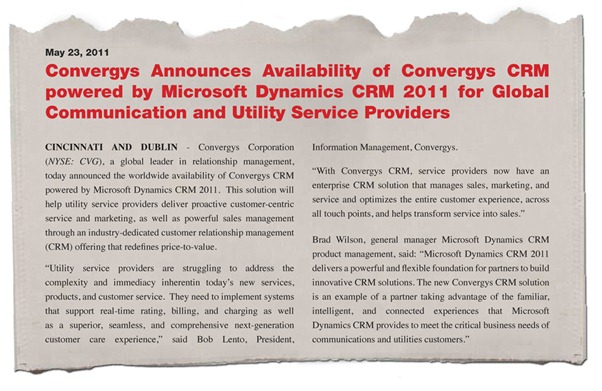Caring for Customers: A “Mashable Ecosystem” Model for Utilities
From our talks around the world with utilities, we hear that many are putting much thought into their Customer Relationship Management systems. The CRM systems that were installed 10 years ago aren’t meeting todays challenges, especially with customer expectations for each companies’ seamless record keeping of each of the customers contact with them, whether by email, phone call or snail mail. And the executives, when looking forward, foresee the customer relationship challenges that will be posed by smart meters and demand response programs, in addition to new billing options for time-of-use pricing and the marketing programs that must promote them. Flexibility and agility, along with stability and ease of use, are first and foremost in mind in our utility friends’ consideration of change.
Interestingly, this transformation of CRM is not only occurring in utilities, but also in the telecoms markets as well, and Microsoft and its partners have been working to address not only the software solutions needed in this new era of CRM, but also the fundamental approach. Ever heard of a “mashable ecosystem for customer care solutions?” You have now.
The “mashable” system we’ve begun advocating is fairly easy to understand. We provide the core platform – Microsoft Dynamics CRM – to our partners with a Customer Care Accelerator tool kit, and they go to work creating joint solutions that provide the customization and innovation that companies need to keep up with their customers. You can read more about this approach from Mark Mortensen, an analyst with Analysys Mason, in a story he wrote yesterday, “Microsoft’s new customer care ecosystem promises agility without vendor lock-in.” As Mortensen says:
For communications service providers (CSPs), the Microsoft ecosystem offers the possibility of a flexible customer care solution that offers high functionality while avoiding vendor lock-in. In this approach, the Microsoft Dynamics CRM system provides the basic CRM capabilities, while other vendors provide the associated advanced features, which are integrated with the Microsoft software. The system includes tools and framework solutions that systems integrators and vendor can use to integrate and automate the federated data architecture, the operations workflows that transcend the individual applications, and the customer care agent’s desktop.
Mortensen notes the relevance of this approach to CSPs, but our readers should know we have already made much progress made with Convergys in providing new solutions tailored to utilities and their unique customer relationships.
In May, Convergys made a big splash with its announcement of the availability of Convergys CRM powered by Microsoft Dynamics CRM 2011
for utility service providers. The announcement notes how Convergys and Microsoft have been working together since February 2010 to deliver a comprehensive, pre-integrated solution that would improve billing processes, customer service and time-to-market for new revenue generating services. The result is a proactive, customer-centric service that helps utilities along the road of making customer service a strategic asset in the operational management philosophy of the company. Ideally, companies can achieve 360-degree views of their customers to reduce handling times with advanced customer service tools. And the new ‘strategic asset” view of CRM delivers service and marketing across the organization, at every customer contact. By streamlining and automating business processes behind the scenes to customers, Convergys believes that Convergys CRM will deliver shorter sales cycles and higher close rates.
It is certainly worth a few minutes to become familiar with these new developments in CRM. We are clearly excited about the energy and experience Convergys brings to our utility clients based on their long experience with utility industry customer service challenges. It’s my hope you will see how the Convergys solution demonstrates our strategy of creating a “mashable ecosystem” for the new CRM era in which we find ourselves. – Jon C. Arnold
